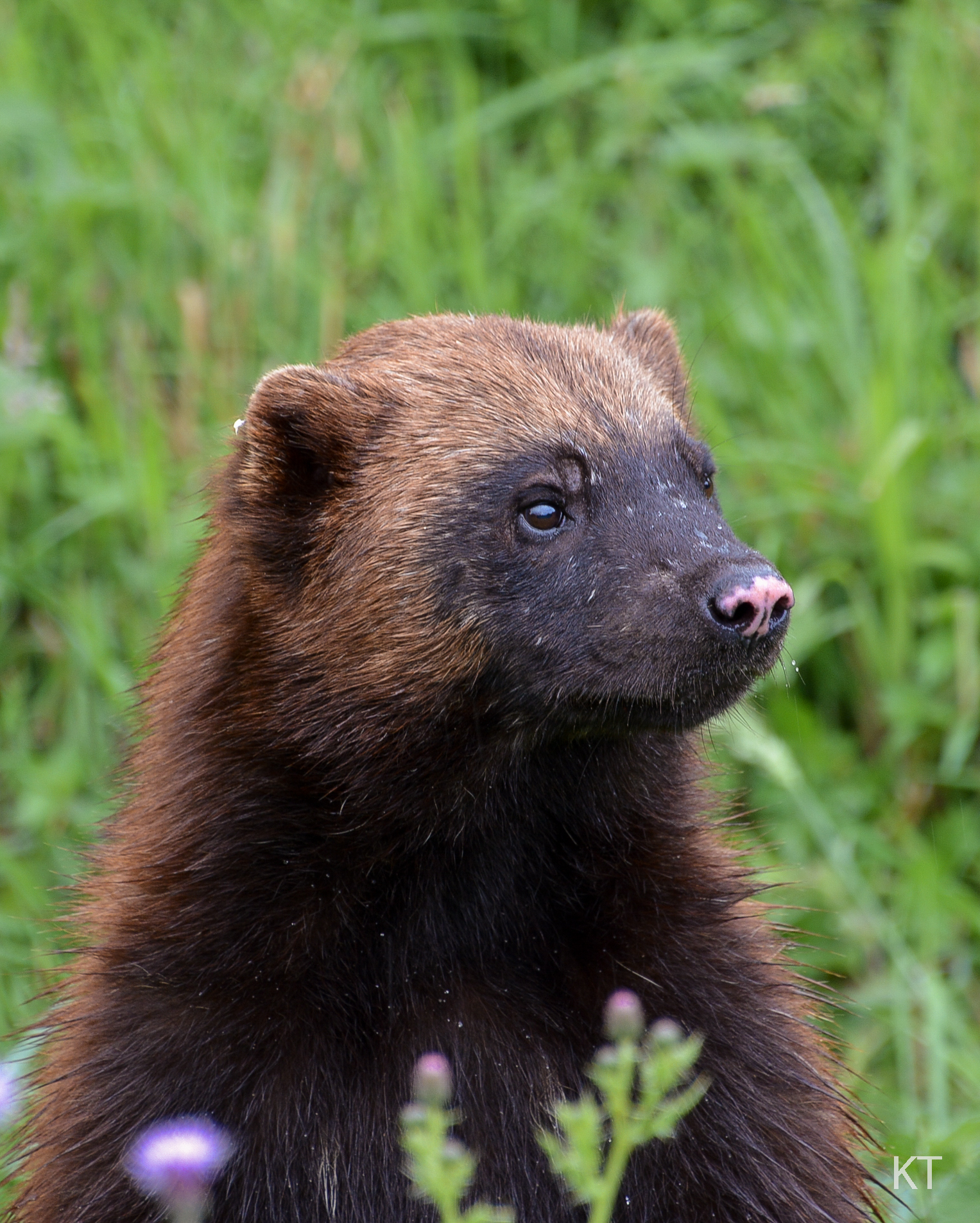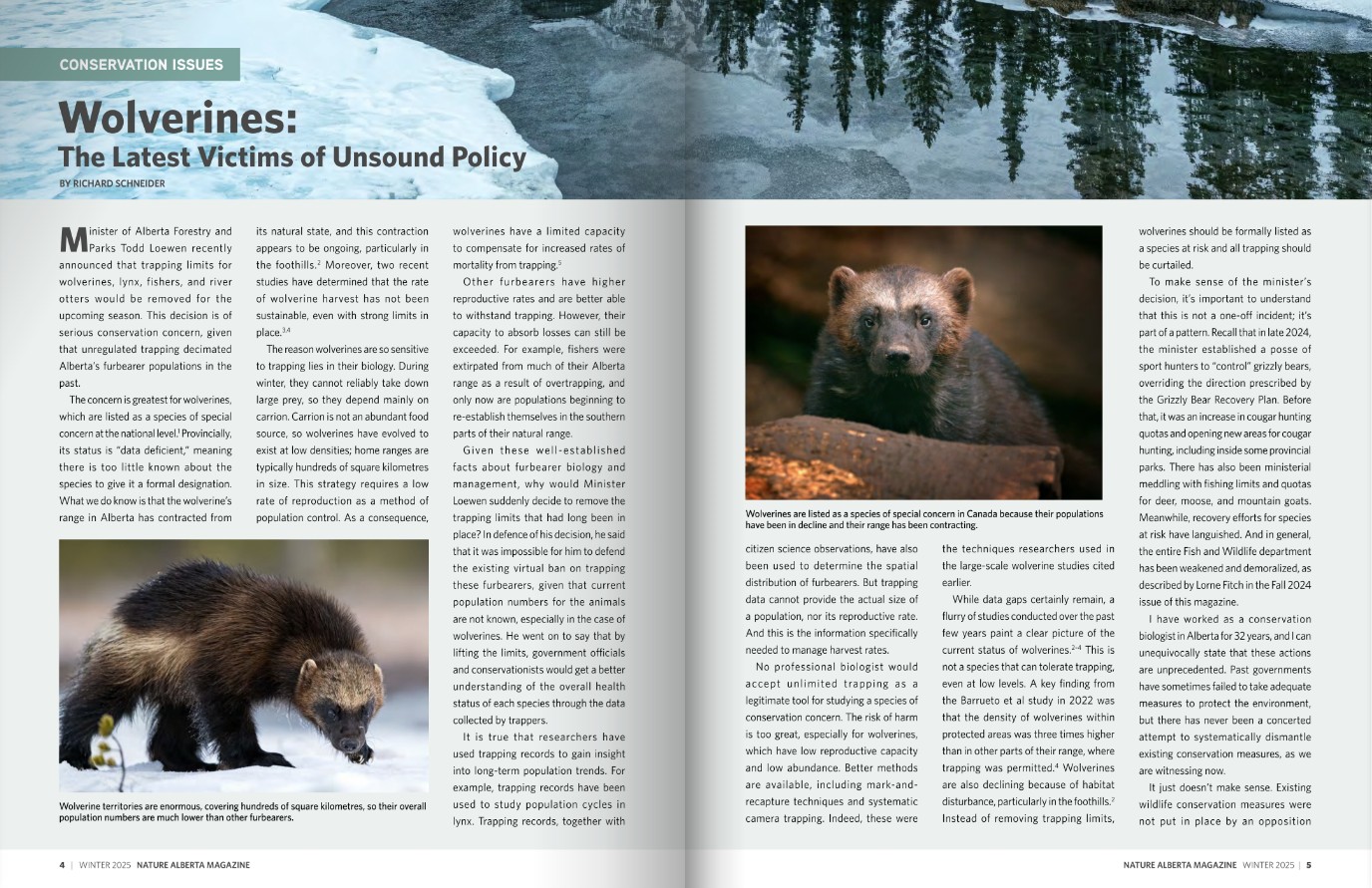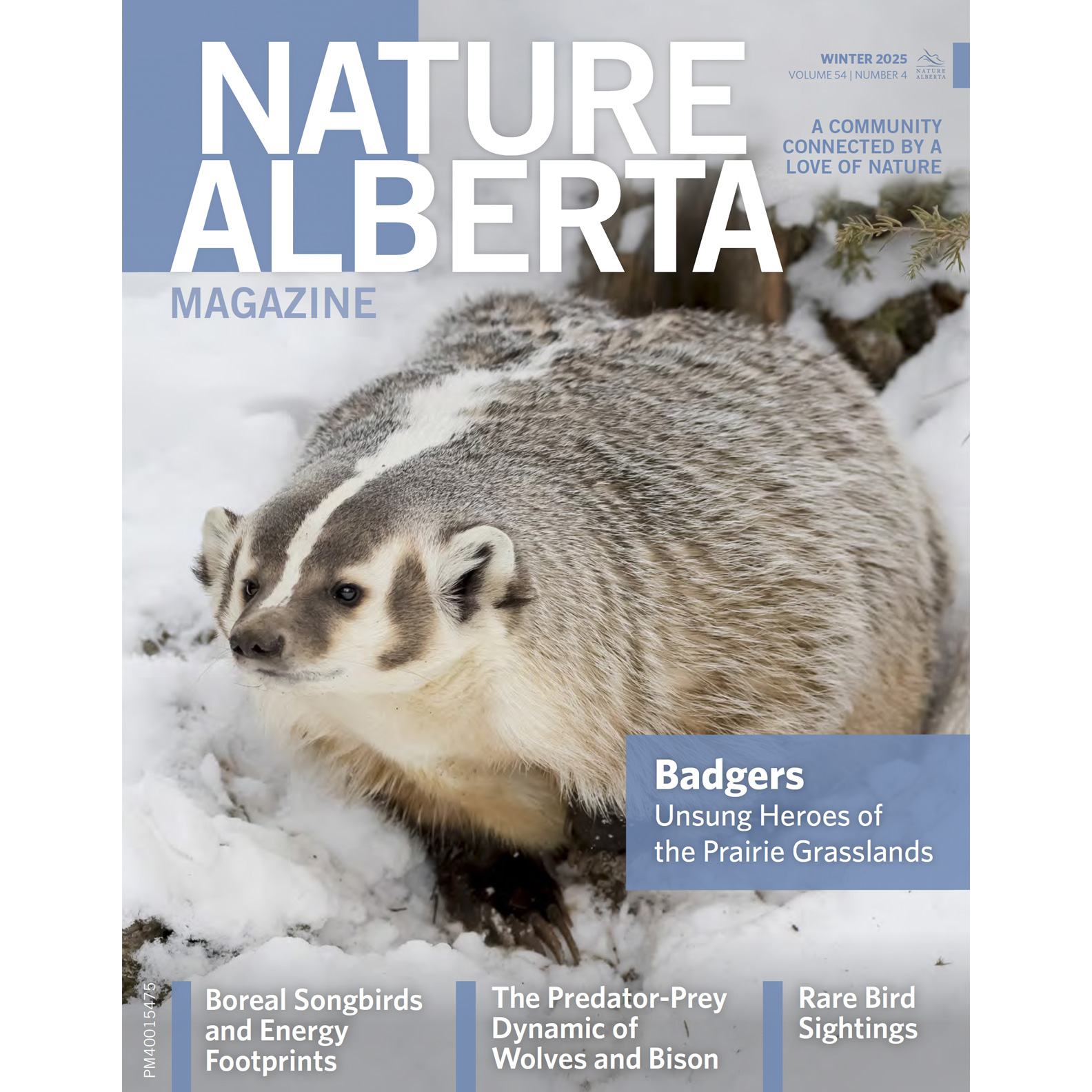Wolverines: The Latest Victim of Unsound Policy
8 January 2025

BY RICHARD SCHNEIDER
Minister of Alberta Forestry and Parks Todd Loewen recently announced that trapping limits for wolverines, lynx, fishers, and river otters would be removed for the upcoming season. This decision is of serious conservation concern, given that unregulated trapping decimated Alberta’s furbearer populations in the past.
The concern is greatest for wolverines, which are listed as a species of special concern at the national level.1 Provincially, its status is “data deficient,” meaning there is too little known about the species to give it a formal designation. What we do know is that the wolverine’s range in Alberta has contracted from its natural state, and this contraction appears to be ongoing, particularly in the foothills.2 Moreover, two recent studies have determined that the rate of wolverine harvest has not been sustainable, even with strong limits in place.3,4
The reason wolverines are so sensitive to trapping lies in their biology. During winter, they cannot reliably take down large prey, so they depend mainly on carrion. Carrion is not an abundant food source, so wolverines have evolved to exist at low densities; home ranges are typically hundreds of square kilometres in size. This strategy requires a low rate of reproduction as a method of population control. As a consequence, wolverines have a limited capacity to compensate for increased rates of mortality from trapping.5
Other furbearers have higher reproductive rates and are better able to withstand trapping. However, their capacity to absorb losses can still be exceeded. For example, fishers were extirpated from much of their Alberta range as a result of overtrapping, and only now are populations beginning to re-establish themselves in the southern parts of their natural range.
Given these well-established facts about furbearer biology and management, why would Minister Loewen suddenly decide to remove the trapping limits that had long been in place? In defence of his decision, he said that it was impossible for him to defend the existing virtual ban on trapping these furbearers, given that current population numbers for the animals are not known, especially in the case of wolverines. He went on to say that by lifting the limits, government officials and conservationists would get a better understanding of the overall health status of each species through the data collected by trappers.
It is true that researchers have used trapping records to gain insight into long-term population trends. For example, trapping records have been used to study population cycles in lynx. Trapping records, together with citizen science observations, have also been used to determine the spatial distribution of furbearers. But trapping data cannot provide the actual size of a population, nor its reproductive rate. And this is the information specifically needed to manage harvest rates.
No professional biologist would accept unlimited trapping as a legitimate tool for studying a species of conservation concern. The risk of harm is too great, especially for wolverines, which have low reproductive capacity and low abundance. Better methods are available, including mark-and-recapture techniques and systematic camera trapping. Indeed, these were the techniques researchers used in the large-scale wolverine studies cited earlier.
While data gaps certainly remain, a flurry of studies conducted over the past few years paint a clear picture of the current status of wolverines.2–4 This is not a species that can tolerate trapping, even at low levels. A key finding from the Barrueto et al study in 2022 was that the density of wolverines within protected areas was three times higher than in other parts of their range, where trapping was permitted.4 Wolverines are also declining because of habitat disturbance, particularly in the foothills.2 Instead of removing trapping limits, wolverines should be formally listed as a species at risk and all trapping should be curtailed.
To make sense of the minister’s decision, it’s important to understand that this is not a one-off incident; it’s part of a pattern. Recall that in late 2024, the minister established a posse of sport hunters to “control” grizzly bears, overriding the direction prescribed by the Grizzly Bear Recovery Plan. Before that, it was an increase in cougar hunting quotas and opening new areas for cougar hunting, including inside some provincial parks. There has also been ministerial meddling with fishing limits and quotas for deer, moose, and mountain goats. Meanwhile, recovery efforts for species at risk have languished. And in general, the entire Fish and Wildlife department has been weakened and demoralized, as described by Lorne Fitch in the Fall 2024 issue of this magazine.
I have worked as a conservation biologist in Alberta for 32 years, and I can unequivocally state that these actions are unprecedented. Past governments have sometimes failed to take adequate measures to protect the environment, but there has never been a concerted attempt to systematically dismantle existing conservation measures, as we are witnessing now.
It just doesn’t make sense. Existing wildlife conservation measures were not put in place by an opposition party pursuing an environmentalist agenda. They were enacted by previous Conservative governments to address public demands for meaningful stewardship of public lands and wildlife. Albertans want and expect the government to achieve a balance between economic and environmental objectives. This has not changed — public demand for effective environmental protection remains strong.
What we are witnessing is a disconnect in governance. The current government is focused on serving a small subset of Albertans rather than the broad public interest, more so than any previous government. The public has also become disconnected. The erosion of environmental protection has advanced piecemeal, flying under the radar of most Albertans. The current political spotlight is dominated by social and economic issues and, when it comes to the environment, the main focus is climate change.
It is unlikely that matters will improve until the public becomes aware of what has been happening and holds the government to account. Such active engagement has happened before, with respect to protecting parks and preventing the expansion of coal mining. It needs to happen again in response to the ongoing dismantling of wildlife protection. Please spread the word among your circles, and make your voice heard by writing to Minister Loewen (fp.minister@gov.ab.ca ) and Premier Danielle Smith (premier@gov.ab.ca), letting them know your concerns. We need wildlife management that is in the broad public interest, science-based, and delivered by experienced and properly resourced wildlife professionals.
References
- Committee on the Status of Endangered Wildlife in Canada (2014). COSEWIC Assessment and Status Report on the Wolverine Gulo gulo in Canada. Environment Canada, Ottawa, ON.
- Chow-Fraser, G. et al. (2022). Landscape change shifts competitive dynamics between declining at-risk wolverines and range-expanding coyotes, compelling a new conservation focus. Biological Conservation, 266:109435.
- Mowat, G. et al. (2020). The sustainability of wolverine trapping mortality in southern Canada. The Journal of Wildlife Management, 84:213-226.
- Barrueto, M. et al. (2022). Protection status, human disturbance, snow cover and trapping drive density of a declining wolverine population in the Canadian Rocky Mountains. Scientific Reports, 12:17412.
- Persson, J. et al. (2006). Reproductive characteristics of female wolverines (Gulo gulo) in Scandinavia. Journal of Mammalogy, 87:75-79.
Richard Schneider is a conservation biologist who has worked on species at risk and land-use planning in Alberta for the past 32 years.
Read the Original Article for this Post
For a richer reading experience, view this article in the professionally designed online magazine with all images and graphs in place.
This article originally ran in the Winter 2025 issue of Nature Alberta Magazine (Vol. 54 | No. 4).


